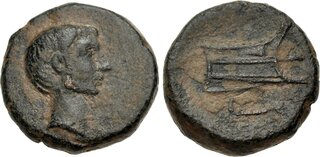Lot description:
ASIA MINOR, Uncertain. Augustus. 27 BC-AD 14. Æ (16mm, 5.38 g, 1h). Bare head right / Prow right; Q below. RPC I 5411; FITA p. 13-19. Earthen red-brown patina, light porosity. Near VF.
This issue has previously been attributed to a Macedonian mint with identification of the portrait as Brutus (Friedlander) or Caesar (Grant). RPC presents a case for a Cilician or Syrian origin, supported by find data, with a suggestion that the portrait is Octavian. Issues of similar portrait style, perhaps by the same engraver, include the Princeps Felix coinage, RPC 4082-3, from Cilicia. New find data indicates with relative certainty that these coins originated in northern Asia Minor.
It is possible that both sets of Cilician or Syrian issues portray Sosius, a leading general of Mark Antony. Sosius was quaestor (symbolized on this coinage with a Q and the symbols of the office) in 39 BC. The island of Zacynthus, a fleet station of Antony's, issued coins in the name of C SOSIVS Q (RPC 1290), C SOSIVS IMP (RPC 1291), C SOSIVS COS DESIG (RPC 1292), and C SOSIVS COS (RPC 1293). The first of these issues coincides with the dating of this coin. Note that both include the "Q" for questor.
Sosius was governor of Syria in 38 BC. Antony supported Herod the Great against his rival Antigonus, and Josephus describes how Sosius commanded the Roman forces in support of Herod's claim. Sosius captured the island and town of Aradus in 38 BC and Jerusalem in July of 37 BC, for which he was acclaimed Imperator. Josephus notes that he was about to allow the soldiers to loot the fallen city and slay its inhabitants, when Herod intervened. Herod asked if the Romans, by emptying the city of money and men, had a mind to leave him to become king of a desert and paid the troops a donative instead, with Sosius himself receiving a "most royal bounty". Sosius called the defeated king the feminine name "Antigona" and imprisoned him for Antony to later execute.
In 36 BC, Sosius assisted Octavian and Agrippa against Sextus Pompey and afterward probably stayed in Rome, where he celebrated a triumph in 34 BC and was consul along with Domitius Ahenobarbus in 32 BC. During his consulship, he rebuilt the Temple of Apollo, which had been constructed in 431 BC. He introduced a measure in the Senate to censure Octavian, but this was vetoed by a tribune. As war between Octavian and Antony approached, Sosius fled Octavian and Rome along with some 300 senators. At Actium in 31 BC, Sosius commanded the left wing of Antony's naval forces. This wing of heavy ships entered the battle first, but was overwhelmed by the smaller, faster ships of Agrippa, commander of Octavian's fleet. Meanwhile, Cleopatra and Antony escaped through the opening created by the movement. Sosius fought on, eventually surrendered, and was spared by Octavian.
Estimate: 100 USD |  |